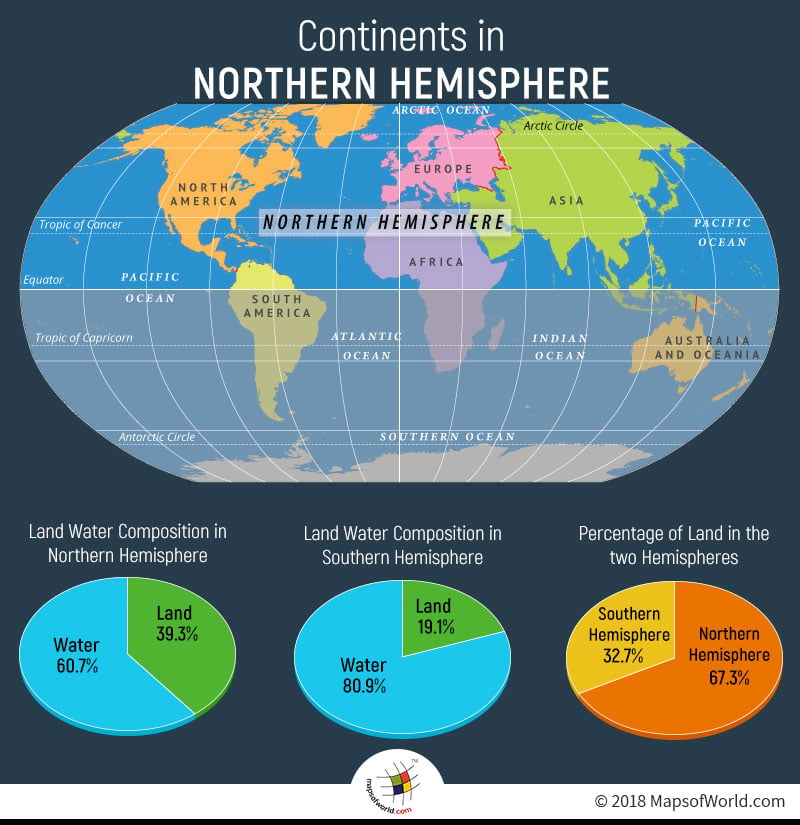

Infographic Depicting The Continents in Northern Hemisphere.
The Equator divides the earth into two equal halves, and Northern Hemisphere forms the north of the equator. 60.7% of the total surface of the Northern Hemisphere is covered with water, in comparison to 80.9% of water in the Southern Hemisphere. Both hemispheres have different geographical climates, owing to the Axial tilt of the earth. It is the reason why the Northern hemisphere witnesses the winter season from December to March, and summers from June to September. Between the Tropic of Cancer and the Equator lies the Tropical zone which is hot all year round. But, due to excessive heat, the rainy season is also experienced during the summer months. Now, 67.3% of Earth’s total land surface comes in the Northern hemisphere, which accounts for why the majority of the continents do form a part of it.
Bordered by the Arctic Ocean to the north, Europe is one of the coldest regions on Earth. The Tropic of Cancer doesn’t pass through it.
Its climate is reliable to the warm Atlantic currents that temper winters and summers on much of the continent. Seasonal differences are more noticeable in countries than the ones close to the coast.
Covering 9,540,000 square miles, North America is the third largest continent in the world and is entirely within the Northern hemisphere. It surpasses both the Arctic Circle and the Tropic of Cancer. From the East Coast to eastern North Dakota, to Kansas, the continent experiences a humid climate with intense seasons and a large amount of rainfall per year.
Central America is on the southern tip of North America and consists of seven countries named: Belize, Costa Rica, El Salvador, Guatemala, Honduras, Nicaragua, and Panama. Trade winds of the tropical region have a significant effect on the climate of Central America.
The Caribbean region has more than 700 islands, islets, reefs, and cays. It has a tropical climate which varies from tropical rain-forest in some areas to tropical savanna in others. Some locations also experience drought.
The largest and most populous continent in the world, Asia also has the majority of the area in the Northern Hemisphere. Only a few parts of countries in the maritime region of Southeast Asia are located in the Southern hemisphere. East Timor, most of Indonesia, and partially Maldives– belong to the Southern hemisphere. 16 countries in Asia, are known to have vulnerable to climate change which included countries of Bangladesh, India, Vietnam, Thailand, Pakistan, and Sri Lanka.
The second largest, and second most populous continent of Africa has two-thirds of its region in the Northern Hemisphere. The countries of Africa which are located below the equator, and are not a part of the Northern Hemisphere are Angola, Botswana, Burundi, Comoros, Lesotho, Madagascar, Malawi, Mauritius, Mayotte (France), Mozambique, Namibia, Réunion (France), Rwanda, Seychelles, South Africa, Swaziland, Tanzania, Zambia, and Zimbabwe. The continent straddles the equator and is the only continent that stretches from the northern temperate to southern temperate zones. The areas lying on the equator are extremely hot.
Five countries of South America lie above the equator. French Guiana, Suriname, Venezuela, partial Ecuador, and most of Colombia belong to the northern hemisphere.
Related Links:
Related Maps:
The Republic of Madagascar is an island country located in the Indian Ocean, off the…
The Euro is the official currency of the European Union. It is, however, not incumbent…
There are many countries or regions that are partially recognized by the UN, have disputes…
The Alaska Statehood Act was signed into law by President Dwight D. Eisenhower in 1958,…
The name Persia may, however, only be used to refer to Iran in some contexts.…
Hawaii is an Island State in the US. It is one of the 50 states…